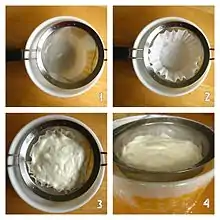Yogurt
Yogurt (UK: /ˈjɒɡərt/; US: /ˈjoʊɡərt/,[1] from Turkish: yoğurt), also spelled yoghurt, yogourt or yoghourt, is a food produced by bacterial fermentation of milk.[2] The bacteria used to make yogurt are known as yogurt cultures. Fermentation of sugars in the milk by these bacteria produces lactic acid, which acts on milk protein to give yogurt its texture and characteristic tart flavor.[2] Cow's milk is commonly available worldwide and, as such, is the milk most commonly used to make yogurt. Milk from water buffalo, goats, ewes, mares, camels, yaks and plant milks are also used to produce yogurt. The milk used may be homogenized or not. It may be pasteurized or raw. Each type of milk produces substantially different results.
 A bowl of yogurt | |
| Type | Dairy product |
|---|---|
| Region or state | Eurasia |
| Serving temperature | Chilled |
| Main ingredients | Milk, bacteria |
Yogurt is produced using a culture of Lactobacillus delbrueckii subsp. bulgaricus and Streptococcus thermophilus bacteria. In addition, other lactobacilli and bifidobacteria are sometimes added during or after culturing yogurt. Some countries require yogurt to contain a specific amount of colony-forming units (CFU) of bacteria; in China, for example, the requirement for the number of lactobacillus bacteria is at least 1 million CFU per milliliter.[3]
To produce yogurt, milk is first heated, usually to about 85 °C (185 °F), to denature the milk proteins so that they do not form curds. After heating, the milk is allowed to cool to about 45 °C (113 °F).[4] The bacterial culture is mixed in, and that temperature of 45 °C is maintained for 4 to 12 hours to allow fermentation to occur.[5]
Etymology and spelling
The word is derived from Turkish: yoğurt,[6] and is usually related to the verb yoğurmak, "to knead", or "to be curdled or coagulated; to thicken".[6] It may be related to yoğun, meaning thick or dense. The sound ğ was traditionally rendered as "gh" in transliterations of Turkish from around 1615–1625.[6] In modern Turkish the letter ğ marks a diaeresis between two vowels, without being pronounced itself, which is reflected in some languages' versions of the word (e.g. Greek γιαούρτι giaoúrti, French yaourt, Romanian iaurt).
In English, the several variations of the spelling of the word include yogurt, yoghurt, and to a lesser extent yoghourt or yogourt.[6]
History
Analysis of the L. delbrueckii subsp. bulgaricus genome indicates that the bacterium may have originated on the surface of a plant.[7] Milk may have become spontaneously and unintentionally exposed to it through contact with plants, or bacteria may have been transferred from the udder of domestic milk-producing animals.[8] The origins of yogurt are unknown, but it is thought to have been invented in Mesopotamia around 5000 BC.[9] In ancient Indian records, the combination of yogurt and honey is called "the food of the gods".[10] Persian traditions hold that "Abraham owed his fecundity and longevity to the regular ingestion of yogurt".[11]

The cuisine of ancient Greece included a dairy product known as oxygala (οξύγαλα) which was similar to yogurt.[12][13][14][15] Galen (AD 129 – c. 200/c. 216) mentioned that oxygala was consumed with honey, similar to the way thickened Greek yogurt is eaten today.[15][14] The oldest writings mentioning yogurt are attributed to Pliny the Elder, who remarked that certain "barbarous nations" knew how "to thicken the milk into a substance with an agreeable acidity".[16] The use of yogurt by medieval Turks is recorded in the books Dīwān Lughāt al-Turk by Mahmud Kashgari and Kutadgu Bilig by Yusuf Has Hajib written in the 11th century.[17][18] Both texts mention the word "yogurt" in different sections and describe its use by nomadic Turks.[17][18] The earliest yogurts were probably spontaneously fermented by wild bacteria in goat skin bags.[19]
Some accounts suggest that Mughal Indian emperor Akbar's cooks would flavor yogurt with mustard seeds and cinnamon.[20] Another early account of a European encounter with yogurt occurs in French clinical history: Francis I suffered from a severe diarrhea which no French doctor could cure. His ally Suleiman the Magnificent sent a doctor, who allegedly cured the patient with yogurt.[20][21] Being grateful, the French king spread around the information about the food that had cured him.
Until the 1900s, yogurt was a staple in diets of people in the Russian Empire (and especially Central Asia and the Caucasus), Western Asia, South Eastern Europe/Balkans, Central Europe, and the Indian subcontinent. Stamen Grigorov (1878–1945), a Bulgarian student of medicine in Geneva, first examined the microflora of the Bulgarian yogurt. In 1905, he described it as consisting of a spherical and a rod-like lactic acid-producing bacteria. In 1907, the rod-like bacterium was called Bacillus bulgaricus (now Lactobacillus delbrueckii subsp. bulgaricus). The Russian biologist and Nobel laureate Ilya Mechnikov, from the Institut Pasteur in Paris, was influenced by Grigorov's work and hypothesized that regular consumption of yogurt was responsible for the unusually long lifespans of Bulgarian peasants.[22] Believing Lactobacillus to be essential for good health, Mechnikov worked to popularize yogurt as a foodstuff throughout Europe.
Isaac Carasso industrialized the production of yogurt. In 1919, Carasso, who was from Ottoman Salonika, started a small yogurt business in Barcelona, Spain, and named the business Danone ("little Daniel") after his son. The brand later expanded to the United States under an Americanized version of the name: Dannon. Yogurt with added fruit jam was patented in 1933 by the Radlická Mlékárna dairy in Prague.[23]
Yogurt was introduced to the United States in the first decade of the twentieth century, influenced by Élie Metchnikoff's The Prolongation of Life; Optimistic Studies (1908); it was available in tablet form for those with digestive intolerance and for home culturing.[24] It was popularized by John Harvey Kellogg at the Battle Creek Sanitarium, where it was used both orally and in enemas,[25] and later by Armenian immigrants Sarkis and Rose Colombosian, who started "Colombo and Sons Creamery" in Andover, Massachusetts in 1929.[26][27]
Colombo Yogurt was originally delivered around New England in a horse-drawn wagon inscribed with the Armenian word "madzoon" which was later changed to "yogurt", the Turkish language name of the product, as Turkish was the lingua franca between immigrants of the various Near Eastern ethnicities who were the main consumers at that time. Yogurt's popularity in the United States was enhanced in the 1950s and 1960s, when it was presented as a health food by scientists like Hungarian-born bacteriologist Stephen A. Gaymont.[28] Plain yogurt still proved too sour for the American palate and in 1966 Colombo Yogurt sweetened the yogurt and added fruit preserves, creating "fruit on the bottom" style yogurt. This was successful and company sales soon exceeded $1 million per year.[29] By the late 20th century, yogurt had become a common American food item and Colombo Yogurt was sold in 1993 to General Mills, which discontinued the brand in 2010.[30]
Market and consumption

In 2017, the average American ate 13.7 pounds of yogurt and that figure has been declining since 2014.
Sale of yogurt was down 3.4 percent over the 12 months ending in February 2019. The decline of Greek-style yogurt has allowed Icelandic style yogurt to gain a foothold in the United States with sales of the Icelandic style yogurt increasing 24 percent in 2018 to $173 million.[31]
Nutrition and health
| Nutritional value per 100 g (3.5 oz) | |
|---|---|
| Energy | 406 kJ (97 kcal) |
3.98 g | |
| Sugars | 4.0 g |
| Dietary fiber | 0 g |
5.0 g | |
9.0 g | |
| Vitamins | Quantity %DV† |
| Vitamin A equiv. | 0% 26 μg22 μg |
| Thiamine (B1) | 2% 0.023 mg |
| Riboflavin (B2) | 23% 0.278 mg |
| Niacin (B3) | 1% 0.208 mg |
| Pantothenic acid (B5) | 7% 0.331 mg |
| Vitamin B6 | 5% 0.063 mg |
| Folate (B9) | 1% 5 μg |
| Vitamin B12 | 31% 0.75 μg |
| Choline | 3% 15.1 mg |
| Vitamin C | 0% 0 mg |
| Minerals | Quantity %DV† |
| Calcium | 10% 100 mg |
| Iron | 0% 0 mg |
| Magnesium | 3% 11 mg |
| Manganese | 0% 0.009 mg |
| Phosphorus | 19% 135 mg |
| Potassium | 3% 141 mg |
| Sodium | 2% 35 mg |
| Zinc | 5% 0.52 mg |
| Other constituents | Quantity |
| Selenium | 9.7 µg |
| Water | 81.3 g |
| |
| †Percentages are roughly approximated using US recommendations for adults. | |
Yogurt (plain yogurt from whole milk) is 81% water, 9% protein, 5% fat, and 4% carbohydrates, including 4% sugars (table). A 100-gram amount provides 406 kilojoules (97 kcal) of dietary energy. As a proportion of the Daily Value (DV), a serving of yogurt is a rich source of vitamin B12 (31% DV) and riboflavin (23% DV), with moderate content of protein, phosphorus, and selenium (14 to 19% DV; table).
| Property | Milk[32] | Yogurt[33] |
|---|---|---|
| Energy | 610 kJ (146 kcal) | 620 kJ (149 kcal) |
| Total carbohydrates | 12.8 g | 12 g |
| Total fat | 7.9 g | 8.5 g |
| Cholesterol | 24 mg | 32 mg |
| Protein | 7.9 g | 9 g |
| Calcium | 276 mg | 296 mg |
| Phosphorus | 222 mg | 233 mg |
| Potassium | 349 mg | 380 mg |
| Sodium | 98 mg | 113 mg |
| Vitamin A | 249 IU | 243 IU |
| Vitamin C | 0.0 mg | 1.2 mg |
| Vitamin D | 96.5 IU | ~ |
| Vitamin E | 0.1 mg | 0.1 mg |
| Vitamin K | 0.5 μg | 0.5 μg |
| Thiamine | 0.1 mg | 0.1 mg |
| Riboflavin | 0.3 mg | 0.3 mg |
| Niacin | 0.3 mg | 0.2 mg |
| Vitamin B6 | 0.1 mg | 0.1 mg |
| Folate | 12.2 μg | 17.2 μg |
| Vitamin B12 | 1.1 μg | 0.9 μg |
| Choline | 34.9 mg | 37.2 mg |
| Betaine | 1.5 mg | ~ |
| Water | 215 g | 215 g |
| Ash | 1.7 g | 1.8 g |
Tilde (~) represents missing or incomplete data. The above shows little difference exists between whole milk and yogurt made from whole milk with respect to the listed nutritional constituents.
Because it may contain live cultures, yogurt is often associated with probiotics, which have been postulated as having positive effects on immune, cardiovascular or metabolic health.[34][35][36] However, to date high-quality clinical evidence has been insufficient to conclude that consuming yogurt lowers the risk of diseases or otherwise improves health.[37]
Varieties and presentation
Dahi is a yogurt from the Indian subcontinent, known for its characteristic taste and consistency. The word dahi seems to be derived from the Sanskrit word dadhi ("sour milk"), one of the five elixirs, or panchamrita, often used in Hindu ritual. Sweetened dahi (mishti doi or meethi dahi) is common in eastern parts of India, made by fermenting sweetened milk. While cow's milk is currently the primary ingredient for yogurt, goat and buffalo milk were widely used in the past, and valued for the fat content (see buffalo curd).
Dadiah or dadih is a traditional West Sumatran yogurt made from water buffalo milk, fermented in bamboo tubes.[38] Yogurt is common in Nepal, where it is served as both an appetizer and dessert. Locally called dahi, it is a part of the Nepali culture, used in local festivals, marriage ceremonies, parties, religious occasions, family gatherings, and so on. One Nepalese yogurt is called juju dhau, originating from the city of Bhaktapur. In Tibet, yak milk (technically dri milk, as the word yak refers to the male animal) is made into yogurt (and butter and cheese) and consumed.
In Northern Iran, Mâst Chekide is a variety of kefir yogurt with a distinct sour taste. It is usually mixed with a pesto-like water and fresh herb purée called delal. Common appetizers are spinach or eggplant borani, Mâst-o-Khiâr with cucumber, spring onions and herbs, and Mâst-Musir with wild shallots. In the summertime, yogurt and ice cubes are mixed together with cucumbers, raisins, salt, pepper and onions and topped with some croutons made of Persian traditional bread and served as a cold soup. Ashe-Mâst is a warm yogurt soup with fresh herbs, spinach and lentils. Even the leftover water extracted when straining yogurt is cooked to make a sour cream sauce called kashk, which is usually used as a topping on soups and stews.
Matsoni is a Georgian yogurt in the Caucasus and Russia. Tarator and Cacık are cold soups made from yogurt during summertime in eastern Europe. They are made with ayran, cucumbers, dill, salt, olive oil, and optionally garlic and ground walnuts. Tzatziki in Greece and milk salad in Bulgaria are thick yogurt-based salads similar to tarator.
Khyar w Laban (cucumber and yogurt salad) is a dish in Lebanon and Syria. Also, a wide variety of local Lebanese and Syrian dishes are cooked with yogurt like "Kibbi bi Laban" Rahmjoghurt, a creamy yogurt with much higher fat content (10%) than many yogurts offered in English-speaking countries. Dovga, a yogurt soup cooked with a variety of herbs and rice, is served warm in winter or refreshingly cold in summer. Jameed, yogurt salted and dried to preserve it, is consumed in Jordan. Zabadi is the type of yogurt made in Egypt, usually from the milk of the Egyptian water buffalo. It is particularly associated with Ramadan fasting, as it is thought to prevent thirst during all-day fasting.[39]
Sweetened and flavored
To offset its natural sourness, yogurt is also sold sweetened, sweetened and flavored or in containers with fruit or fruit jam on the bottom.[40] The two styles of yogurt commonly found in the grocery store are set-style yogurt and Swiss-style yogurt. Set-style yogurt is poured into individual containers to set, while Swiss-style yogurt is stirred prior to packaging. Either may have fruit added to increase sweetness.[40]
Lassi is a common Indian beverage made from stirred liquified yogurt that is either salted or sweetened with sugar commonly, less commonly honey and combined with fruit pulp to create flavored lassi.[41] Consistency can vary widely, with urban and commercial lassis having uniform texture through being processed, whereas rural and rustic lassi has discernible curds or fruit pulp.[41]
Large amounts of sugar – or other sweeteners for low-energy yogurts – are often used in commercial yogurt.[40][42] Some yogurts contain added modified starch,[43] pectin (found naturally in fruit) or gelatin to create thickness and creaminess. This type of yogurt may be marketed under the name Swiss-style, although it is unrelated to conventional Swiss yogurt. Some yogurts, often called "cream line", are made with whole milk which has not been homogenized so the cream rises to the top. In many countries, sweetened, flavored yogurt is common, typically sold in single-serving plastic cups.[40] Common flavors may include vanilla, honey, and toffee, and various fruits.[40][42] In the early 21st century, yogurt flavors inspired by desserts, such as chocolate or cheesecake, became common.[42] There is concern about the health effects of sweetened yogurt due to its high sugar content,[40] although research indicates that use of sugar in yogurt manufacturing has decreased since 2016 in response to WHO and government initiatives to combat obesity.[40][44]
Straining

Strained yogurt has been strained through a filter, traditionally made of muslin and more recently of paper or non-muslin cloth. This removes the whey, giving a much thicker consistency. Strained yogurt is made at home, especially if using skimmed milk which results in a thinner consistency.[45] Yogurt that has been strained to filter or remove the whey is known as Labneh in Middle Eastern countries. It has a consistency between that of yogurt and cheese. It may be used for sandwiches in Middle Eastern countries. Olive oil, cucumber slices, olives, and various green herbs may be added. It can be thickened further and rolled into balls, preserved in olive oil, and fermented for a few more weeks. It is sometimes used with onions, meat, and nuts as a stuffing for a variety of pies or kibbeh balls.
Some types of strained yogurts are boiled in open vats first, so that the liquid content is reduced. The East Indian dessert, a variation of traditional dahi called mishti dahi, offers a thicker, more custard-like consistency, and is usually sweeter than western yogurts.[46] In western Indian (Marathi and Gujarati) cuisine, strained yogurt is macerated with sugar and spices such as saffron, cardamom and nutmeg to make the dessert "shrikhand". Strained yogurt is also enjoyed in Greece and is the main component of tzatziki (from Turkish "cacık"), a well-known accompaniment to gyros and souvlaki pita sandwiches: it is a yogurt sauce or dip made with the addition of grated cucumber, olive oil, salt and, optionally, mashed garlic. Srikhand, a dessert in India, is made from strained yogurt, saffron, cardamom, nutmeg and sugar and sometimes fruits such as mango or pineapple.
In North America, strained yogurt is commonly called "Greek yogurt". Powdered milk is sometimes added in lieu of straining to achieve thickness. In Britain as "Greek-style yogurt". In Britain the name "Greek" may only be applied to yogurt made in Greece.[47]
Beverages
Ayran, doogh ("dawghe" in Neo-Aramaic) or dhallë is a yogurt-based, salty drink. It is made by mixing yogurt with water and (sometimes) salt.
Borhani (or burhani) is a spicy yogurt drink from Bangladesh. It is usually served with kacchi biryani at weddings and special feasts. Key ingredients are yogurt blended with mint leaves (mentha), mustard seeds and black rock salt (Kala Namak). Ground roasted cumin, ground white pepper, green chili pepper paste and sugar are often added.
Lassi is a yogurt-based beverage that is usually slightly salty or sweet, and may be commercially flavored with rosewater, mango or other fruit juice. Salty lassi is usually flavored with ground, roasted cumin and red chilies, may be made with buttermilk.
An unsweetened and unsalted yogurt drink usually called simply jogurt is consumed with burek and other baked goods in the Balkans. Sweetened yogurt drinks are the usual form in Europe (including the UK) and the US, containing fruit and added sweeteners. These are typically called "drinkable yogurt". Also available are "yogurt smoothies", which contain a higher proportion of fruit and are more like smoothies.
Plant milk yogurt
A variety of plant milk yogurts appeared in the 2000s, using soy milk, rice milk, and nut milks such as almond milk and coconut milk fermented with yogurt cultures. These yogurts are suitable for vegans, people with intolerance to dairy milk, and those who prefer plant-based products, and are more environmentally friendly as they are produced with fewer resources, water and land.[48][49]
Production

Yogurt is made by heating milk to a temperature that denaturates its proteins (scalding), essential for making yogurt,[50] cooling it to a temperature that will not kill the live microorganisms that turn the milk into yogurt, inoculating certain bacteria (starter culture), usually Streptococcus thermophilus and Lactobacillus bulgaricus, into the milk, and finally keeping it warm for several hours. The milk may be held at 85 °C (185 °F) for a few minutes, or boiled (giving a somewhat different result). It must be cooled to 50 °C (122 °F) or somewhat less, typically 40–46 °C (104–115 °F). Starter culture must then be mixed in well, and the mixture must be kept undisturbed and warm for some time, anywhere between 5 and 12 hours. Longer fermentation times produces a more acidic yogurt. The starter culture may be a small amount of live (not sterilized) existing yogurt or commercially available dried starter culture.
Milk with a higher concentration of solids than normal milk may be used; the higher solids content produces a firmer yogurt. Solids can be increased by adding dried milk.[51] The yogurt-making process provides two significant barriers to pathogen growth, heat and acidity (low pH). Both are necessary to ensure a safe product. Acidity alone has been questioned by recent outbreaks of food poisoning by E. coli O157:H7 that is acid-tolerant. E. coli O157:H7 is easily destroyed by pasteurization (heating); the initial heating of the milk kills pathogens as well as denaturing proteins.[52] The microorganisms that turn milk into yogurt can tolerate higher temperatures than most pathogens, so that a suitable temperature not only encourages the formation of yogurt, but inhibits pathogenic microorganisms. Once the yogurt has formed it can, if desired, be strained to reduce the whey content and thicken it.
Commercial yogurt
Two types of yogurt are supported by the Codex Alimentarius for import and export.[53]
- Pasteurized yogurt ("heat treated fermented milk")[53] is yogurt pasteurized to kill bacteria.[54]
- Probiotic yogurt (labeled as "live yogurt" or "active yogurt") is yogurt pasteurized to kill bacteria, with Lactobacillus added in measured units before packaging.
- Yogurt probiotic drink is a drinkable yogurt pasteurized to kill bacteria, with Lactobacillus added before packaging.
Under US Food and Drug Administration regulations, milk must be pasteurized before it is cultured, and may optionally be heat treated after culturing to increase shelf life.[55] Most commercial yogurts in the United States are not heat treated after culturing, and contain live cultures.
Yogurt with live cultures[56][57][58] is more beneficial than pasteurized yogurt for people with lactose malabsorption.[59]
Lactose intolerance
Lactose intolerance is a condition in which people have symptoms due to the decreased ability to digest lactose, a sugar found in dairy products. In 2010, the European Food Safety Authority (EFSA) determined that lactose intolerance can be alleviated by ingesting live yogurt cultures (lactobacilli) that are able to digest the lactose in other dairy products.[59] The scientific review by EFSA enabled yogurt manufacturers to use a health claim on product labels, provided that the "yogurt should contain at least 108 CFU live starter microorganisms (Lactobacillus delbrueckii subsp. bulgaricus and Streptococcus thermophilus) per gram. The target population is individuals with lactose maldigestion."[59]
Gallery
 Doogh is a savory yogurt-based beverage, traditionally served cold and is sometimes carbonated and seasoned with mint and salt.
Doogh is a savory yogurt-based beverage, traditionally served cold and is sometimes carbonated and seasoned with mint and salt.
 Raita is a condiment made with yogurt in the Indian subcontinent
Raita is a condiment made with yogurt in the Indian subcontinent Dadiah in a market
Dadiah in a market Plant milk yogurt
Plant milk yogurt Home yogurt maker
Home yogurt maker A drinkable yogurt made from water buffalo milk
A drinkable yogurt made from water buffalo milk
See also
References
- "YOGURT | meaning in the Cambridge English Dictionary". dictionary.cambridge.org. Retrieved 17 February 2020.
- "Yogurt: from Part 131 – Milk and Cream. Subpart B – Requirements for Specific Standardized Milk and Cream, Sec. 131.200". Code of Federal Regulations, Title 21, US Food and Drug Administration. 1 April 2016.
- Lee YK, et al. (2012). "Probiotic Regulation in Asian Countries". In Lahtinen S, et al. (eds.). Lactic Acid Bacteria: Microbiological and Functional Aspects (Fourth ed.). Boca Raton: CRC Press. p. 712. ISBN 9780824753320.
- Chandan RC, Kilara A (22 December 2010). Dairy Ingredients for Food Processing. John Wiley & Sons. pp. 1–. ISBN 978-0-470-95912-1.
- Clark M. "Creamy Homemade Yogurt Recipe". NYT Cooking. Retrieved 19 March 2017.
- "Yogurt". Collins English Dictionary – Complete & Unabridged 10th Edition. HarperCollins. 2012. Retrieved 21 March 2017.
- "The sequence of the lactobacillus genome in yogurt unveiled". 16 June 2006. Retrieved 16 January 2012.
- "Yogurt Culture Evolves". livescience.com. 9 June 2006. Retrieved 16 January 2012.
- Tribby D (2009). "Yogurt". In Clark C, et al. (eds.). The Sensory Evaluation of Dairy Products. Springer Science & Business Media. p. 191. ISBN 9780387774084.
- Batmanglij, Najmieh (2007). A Taste of Persia: An Introduction to Persian Cooking. I.B.Tauris. p. 170. ISBN 978-1-84511-437-4.
- Farnworth ER (2008). Handbook of fermented functional foods. Taylor and Francis. p. 114. ISBN 978-1-4200-5326-5.
- Dalby A (1996). Siren Feasts: A History of Food and Gastronomy in Greece. London: Routledge. p. 66. ISBN 0-415-15657-2.
- Alcock JP (2006). Food in the Ancient World. Greenwood Publishing Group. p. 83. ISBN 9780313330032.
Curdled milk (oxygala or melca), probably a kind of yogurt, was acceptable because it was easier to digest. Even so, it was still to be mixed with honey or olive oil. Columella gave instructions on how to make sour milk with seasoning into ...
- Hoffman S (2004). The Olive and the Caper: Adventures in Greek Cooking. Workman Publishing. p. 471. ISBN 9780761164548.
...something like yogurt was known to Greeks since classical times – a sort of thickened sour milk called Pyriate or oxygala. Oxi meant “sour” or “vinegar”; gala, “milk”. Galen says that Oxygala was eaten alone with honey, just as thick Greek yogurt is today.
- Adamson MW (2008). Entertaining from Ancient Rome to the Super Bowl: An Encyclopedia [2 volumes]: An Encyclopedia. ABC-CLIO. p. 9. ISBN 9780313086892.
Oxygala, however, a form of yogurt, was eaten and sometimes mixed with honey. Ancient Greek and Roman cuisine did not rely on non-cultured milk products, which can be explained in part because without refrigeration milk becomes sour ...
- The Natural History of Pliny, tr. John Bostock, Henry Thomas Riley, London: Bell, 1856–93, Volume 3, p. 84: "It is a remarkable circumstance, that the barbarous nations which subsist on milk have been for so many ages either ignorant of the merits of cheese, or else have totally disregarded it; and yet they understand how to thicken milk and form therefrom an acrid kind of milk with a pleasant flavor".
- Toygar K (1993). Türk Mutfak Kültürü Üzerine Araştırmalar. Türk Halk Kültürünü Araştırma ve Tanıtma Vakfı. p. 29. ISBN 9789757878001. Retrieved 11 August 2009.
- Ögel B (1978). Türk Kültür Tarihine Giriş: Türklerde Yemek Kültürü. Kültür Bakanlığı Yayınları. p. 35. Retrieved 11 August 2009.
- Biancalana A. "Yogurt – Aquavitae". DiWineTaste. Retrieved 21 February 2012.
- Coyle LP (1982). The World Encyclopedia of Food. Facts On File Inc. p. 763. ISBN 978-0-87196-417-5. Retrieved 11 August 2009.
- Rosenthal SD (1978). Fresh Food. Bookthrift Co. p. 157. ISBN 978-0-87690-276-9. Retrieved 11 August 2009.
- Brown AC, Valiere A (1 January 2004). "Probiotics and medical nutrition therapy". Nutrition in Clinical Care. 7 (2): 56–68. PMC 1482314. PMID 15481739.
- "První ovocný jogurt se narodil u Vltavy" (in Czech). ekonomika.idnes.cz. 23 July 2002. Retrieved 27 April 2009.
- Annual report of the Agricultural Experiment Station of the University of Wisconsin (Report). Volumes 25–26 (1907–09 ed.). pp. 29, 197, 205–206.
- "Dr. John Harvey Kellogg." museumofquackery.com, 20 April 2010, Retrieved 12 November 2010.
- "Object of the Month". The Massachusetts Historical Society. June 2004.
- "Colombo Yogurt – First U.S. Yogurt Brand – Celebrates 75 Years". Business Wire. 13 May 2004.
- Smith, Andrew (2013). The Oxford Encyclopedia of Food and Drink in America. 2. p. 644. ISBN 9780199739226.
- Denker J (2003). The World on a Plate: A Tour Through the History of America's Ethnic Cuisine. University of Nebraska Press. ISBN 0803260148.
- "General Mills to discontinue producing Colombo Yogurt". Eagle-Tribune. 29 January 2010. Archived from the original on 28 May 2011. Retrieved 29 April 2010.
- Patton L (17 April 2019). "In the Yogurt World, the Greeks Are Down and Vikings Are Up". Bloomberg News. Retrieved 18 April 2019.
- "Milk, whole, 3.25% milkfat". Self Nutrition Data, know what you eat. Conde Nast. Retrieved 21 July 2015.
- "Yogurt, plain, whole milk, 8 grams protein per 8 oz". Self Nutrition Data, know what you eat. Conde Nast. Retrieved 21 July 2015.
- El-Abbadi NH, Dao MC, Meydani SN (May 2014). "Yogurt: role in healthy and active aging". The American Journal of Clinical Nutrition. 99 (5 Suppl): 1263S–1270S. doi:10.3945/ajcn.113.073957. PMC 6410895. PMID 24695886.
- Astrup A (May 2014). "Yogurt and dairy product consumption to prevent cardiometabolic diseases: epidemiologic and experimental studies". The American Journal of Clinical Nutrition. 99 (5 Suppl): 1235S–1242S. doi:10.3945/ajcn.113.073015. PMID 24695891.
- Gijsbers L, Ding EL, Malik VS, de Goede J, Geleijnse JM, Soedamah-Muthu SS (April 2016). "Consumption of dairy foods and diabetes incidence: a dose-response meta-analysis of observational studies". The American Journal of Clinical Nutrition. 103 (4): 1111–1124. doi:10.3945/ajcn.115.123216. PMID 26912494.
- Rijkers GT, de Vos WM, Brummer RJ, Morelli L, Corthier G, Marteau P (November 2011). "Health benefits and health claims of probiotics: bridging science and marketing". The British Journal of Nutrition. 106 (9): 1291–1296. doi:10.1017/S000711451100287X. PMID 21861940.
- Surono IS (1 January 2015). "Traditional Indonesian dairy foods". Asia Pacific Journal of Clinical Nutrition. 24 Suppl 1 (S1): S26–S30. doi:10.6133/apjcn.2015.24.s1.05. PMID 26715081.
- Acidified milk in different countries. Fao.org. Retrieved on 9 April 2013.
- Moore JB, Horti A, Fielding BA (September 2018). "Evaluation of the nutrient content of yogurts: a comprehensive survey of yogurt products in the major UK supermarkets". BMJ Open. 8 (8): e021387. doi:10.1136/bmjopen-2017-021387. PMC 6144340. PMID 30228100.
- Cloake F (21 May 2015). "How to make the perfect mango lassi". The Guardian. Retrieved 8 January 2020.
- Berry D (20 May 2014). "Building a better yogurt". Food Business News, Sosland Publishing. Retrieved 8 January 2020.
- Alting AC, Fred Van De Velde, Kanning MW, Burgering M, Mulleners L, Sein A, Buwalda P (2009). "Improved creaminess of low-fat yogurt: The impact of amylomaltase-treated starch domains". Food Hydrocolloids. 23 (3): 980–987. doi:10.1016/j.foodhyd.2008.07.011.
- Moore JB, Sutton EH, Hancock N (8 January 2020). "Sugar reduction in yogurt products sold in the UK between 2016 and 2019". Nutrients. 12 (1): 171. doi:10.3390/nu12010171. PMC 7019219. PMID 31936185.
- Davidson A (2014). The Oxford Companion to Food. Oxford University Press. ISBN 9780191040726.
- Hui, ed. Ramesh C. Chandan, associate editors, Charles H. White, Arun Kilara, Y. H. (2006). Manufacturing yogurt and fermented milks (1. ed.). Ames (Iowa): Blackwell. p. 364. ISBN 9780813823041.CS1 maint: extra text: authors list (link)
- 'Greek' yogurt Chobani firm loses legal battle. BBC (29 January 2014).
- Barnes A (17 January 2019). "Choosing Dairy-Free In 2019: Chobani Disrupting Yogurt Market With Plant-Based Product". Forbes. Retrieved 30 March 2019.
- Plant‐based Milks: A Review of the Science Underpinning Their Design, Fabrication, and Performance, David Julian McClements, Emily Newman, Isobelle Farrell McClements- First published: 18 October 2019
- Parnell-Clunies EM, Kakuda Y, Mullen K, Arnott DR, Deman JM (1986). "Physical Properties of Yogurt: A Comparison of Vat Versus Continuous Heating Systems of Milk". Journal of Dairy Science. 69 (10): 2593–2603. doi:10.3168/jds.S0022-0302(86)80706-8.
- Hutkins R. "Making Yogurt at Home". Univ. of Nebraska. Archived from the original on 23 August 2006. Retrieved 8 January 2013.
- Nummer BA. "Fermenting Yogurt at Home". National Center for Home Food Preservation. Archived from the original on 24 November 2011. Retrieved 8 January 2013.
- "Milk and milk products, 2nd Ed. Codex Alimentarius" (PDF). UN Food and Agriculture Organization and World Health Organization. 2011.
- Ray R, Didier M (2014). Microorganisms and Fermentation of Traditional Foods. CRC press. ISBN 9781482223088.
- "Code of Federal Regulations Title 21, Sec. 131.200 Yogurt". US Food and Drug Administration. 1 April 2017.
- Maisonneuve S, Ouriet MF, Duval-Iflah Y (June 2001). "Comparison of yoghurt, heat treated yoghurt, milk and lactose effects on plasmid dissemination in gnotobiotic mice". Antonie van Leeuwenhoek. 79 (2): 199–207. doi:10.1023/A:1010246401056. PMID 11520006. S2CID 11673881.
- Piaia M, Antoine J, Mateos-Guardia J, Leplingard A, Lenoir-Wijnkoop I (2009). "Assessment of the Benefits of Live Yogurt: Methods and Markers forin vivo Studies of the Physiological Effects of Yogurt Cultures". Microbial Ecology in Health and Disease. 15 (2–3): 79–87. doi:10.1080/08910600310019336. S2CID 218565763.
- Kalantzopoulos G (1997). "Fermented products with probiotic qualities". Anaerobe. 3 (2–3): 185–190. doi:10.1006/anae.1997.0099. PMID 16887587.
- "Scientific Opinion on the substantiation of health claims related to live yogurt cultures and improved lactose digestion (ID 1143, 2976) pursuant to Article 13(1) of Regulation (EC) No 1924/2006". EFSA Journal. 8 (10). 2010. doi:10.2903/j.efsa.2010.1763.
Live yogurt cultures in yogurt improve digestion of lactose in yogurt in individuals with lactose maldigestion

